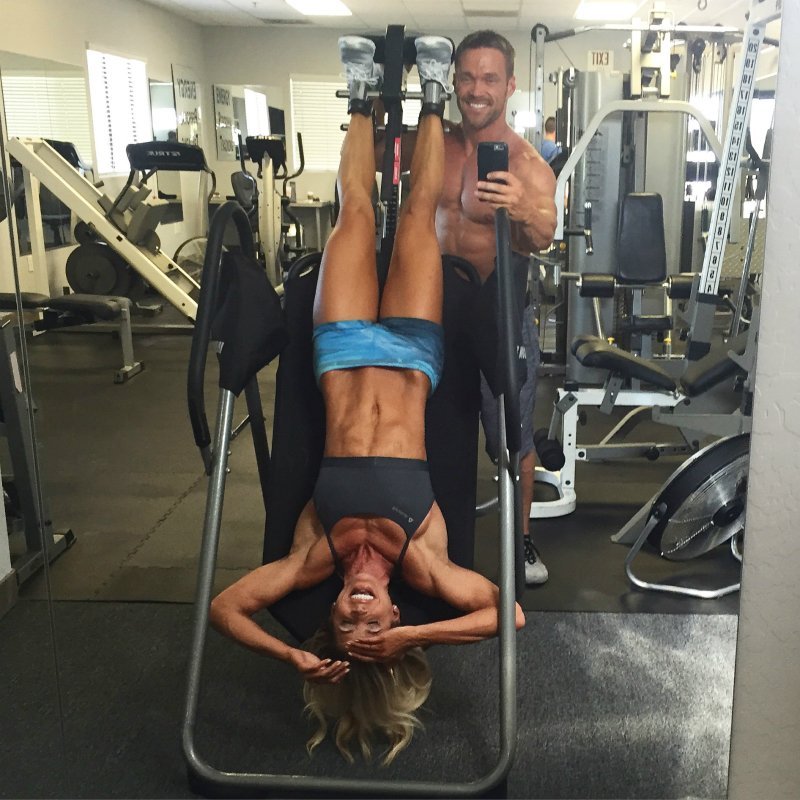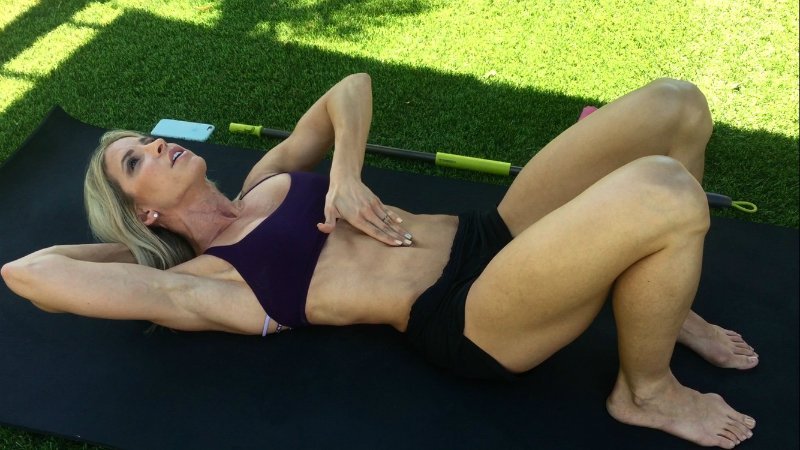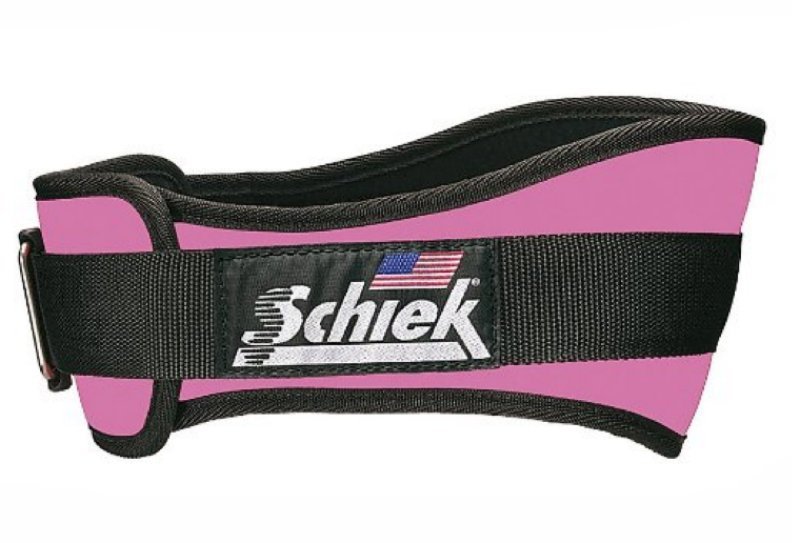Ok, here it is! Girl to girl, we need to discuss something I THINK is more common than I’ve ever believed! I’m getting a little personal and a little science-y on you today to talk about diastasis recti. Diastasis rect-who? Rect-ME! (Ok, stop).
I’m going to warn you up front. There is SO much to cover in this post—it’s a little long. If you wanna’ get straight to the meat (or the exercises you can do to fix your diastasis recti), scroll down. If you wanna’ learn more and figure out if you have this condition, keep reading.
Let me get you up to speed. Diastasis recti generally happens during pregnancy when the two large parallel bands of abdominal muscles separate due to the expanding uterus. Some women’s ab muscles go back to normal after the baby is born, and some do not…mine never have, and chances are yours haven’t either—which is why you are here.
The good news is that the diastasis caused by pregnancy can be corrected with exercises and stretches designed to optimize deep core muscular function. So ladies, don’t worry—your body wants to function right, and it will. We just need to wake up the right core muscles and teach them what to do! But let’s not get ahead of ourselves. Saving that for later.
Now how this happens and why it is worse for some women, no one is 100% sure. But we can hypothesize. It’s been said to be hereditary, but it may also be caused by working out your abs too soon after a baby is born, or even doing the wrong exercises WHILE pregnant. While I didn’t workout during ALL of my pregnancies (just the last 2), I personally feel like working my abs hard during prego worsened my condition. But that’s just my opinion.
Crazy fact, I didn’t even notice my ab separation until after Cash was born!! Yes, 3 kids later. I mean, I knew it was there, but I didn’t realize it was a medical condition. Embarrassingly enough, I always just thought I had definition down the center of my abs! Ha! Nope…wishful thinking. Just diastasis. Once I realized this odd look my midsection had wasn’t normal, nor was it normal for me to be able to literally stick my hand inside of my abs and touch my insides with just skin separating, I knew I had to do something about it. If you’d like a visual, just check out the pic below. This was posted on social media a couple of weeks back, and I got an overwhelming response from women (you!) that suffer from the same condition…
From a medical standpoint, until recently, I had a little over a 3-finger sized gap between my abs that was physically unprotected. Like I said, intestines…right below my skin. And during certain ab exercises, my insides would actually protrude through my abs, forming a weird point. Disgusting, I know. And it’s even scarier to think how vulnerable my vital organs were. If this went untreated, I could suffer from a major intestinal hernia, and given my level of activity (and types of heavy lifting), chances of this happening are higher than most. I mean, I already have an obvious umbilical hernia (my dramatic outtie belly button) so I figure I am more prone than most…
Extensive research on the topic taught me a few things…one of them being there are a handful of factors that make a woman more susceptible to diastasis recti:
- Having more than one child/pregnancy
- Having pregnancies close together
- Being?over the age of 35
- Having big babies
- Having multiple births
I know…some of you are looking at this ist realizing you’ve been double—or even quadruple—whammied! (I?m raising my hand to a couple). Don?t beat yourself up about what you cannot change because diastasis recti is very common—about 67% of all postpartum women have it. So you (and I) are in good company.
If you’re not sure if you are among the lucky few who steered clear of this pregnancy consequence, here’s an easy way to check:
- Lie on your back with your knees bent, soles of your feet close to your booty.
- Place one hand behind your neck and the other hand on your abdomen with your fingertips flat at your belly button, fingers facing downward.
- Gently push your fingertips into your abdomen while rolling your upper body off of the floor, chin towards the ceiling.
- Feel for a separation between those two ab muscles. Experts say that a 2-2.5 finger or more spread signals diastasis recti.
Now, let’s talk about our options moving forward. We can go the immediate and potentially easy (but expensive) route with surgery. BUT, surgery is not always recommended if you are still in your childbearing years…I mean think about it, one more baby, and you’ll pop those abs right back apart! As well, there is no guarantee that surgery will be 100% effective. (SIDE NOTE…Research on this topic started once Chris told me NO to this option because he wants more babies! Another topic for another day…but…).
So for me, at-home exercises and remedies are the way to go. Anytime I can avoid going under the knife, I will. And worst case? If the exercises don’t work, surgery as an option is always going to be there.
Before we go farther—a very important disclaimer: The following “fixes” are all based on my experience and my research, so please check with your doc BEFORE doing anything for your diastasis recti since each case is different. Okay, here goes:
Over this past year, my training protocol has changed as I have transitioned from CrossFit-style workouts to body building. Along with the training change-up, I changed the way I worked my abs too, focusing on decreasing (actually eliminating) the typical ab exercises and increasing the deep-core muscle exercises. I am happy to report that over this year, my abdominal muscle separation has decreased dramatically to less than 2 fingers!! But it still isn’t quite where I need it to be to consider myself healed.
The proof is in the pudding for me: A lot of this boils down to doing the RIGHT exercises. I realize that for so long I was doing what I intuitively thought would work (swing ups, sit ups, V ups, knees to bar, etc), but in reality, these move were working against me by ONLY working my Rectus Abdominus. The REAL muscles that needed working are known as the Transversus Abdominus and Lumbar Multifidus. These are the the most neglected of the ab muscles, but also happen to be arguably the most important. They lie beneath the Rectus Abdominus, supporting posture, controlling breathing during heavy lifts, and supporting the back. These are the muscles elite athletes work to add explosive power to training and are also the muscles we mamas need to work to relieve back pain, create a tighter midsection, AND improve our diastasis recti.
Some at-home exercises you can do to focus on these important muscles are below. I’ve also recorded a demonstration video for you (at the bottom of the post) so you can SEE how to perform these moves right and hear my instructions. Make sure that when you do these moves, you focus and move slowly—keeping the mind body connection. In other words, don’t just go through the moves. You’ll notice that breathing is a KEY component to all of these movements: Deep inhales, and exhale when you activate the muscles.
-
- Drawing In Exercise: Now technically every single move listed below requires you to “draw in,” so I figured I would do a little explaining. Drawing in is NOT sucking in (which uses the outer muscles). Drawing in is done by allowing those inner muscles to pull your abdomen deep inside toward your spine. Draw in from the lower region of your abs. Drawing in is something you can do in sets for as long as you can hold (work up to 60 seconds at a time), or it’s something you can simply do as you walk around your house. Believe it or not, your posture will improve big time with this! This can be done standing, sitting, lying down…you name it. Just DRAW IN!
- Vacuuming: No…not vacuuming your carpet (although I guess technically you can vacuum ON your carpet). I’m talking about the core exercise known by this name. I know I’ve talked about this before, but I’m going to talk about it again. Easily explained, simply stand up straight, inhale deeply, followed by an exhale. Once all of the air is deflated from your lungs, draw your belly button in and up toward your spine. HOLD (as tough as it is) for as long as you can. I aim for 30 seconds, but if holding your breath that long isn’t doable, simply keep the clock running and keep your belly button in and tight as you slowly breathe for the remainder of the 30 seconds. Try for 5-10 reps a day.
- Broomstick Rotations: With a dowel or a broomstick behind your neck, perform a vacuum, then when all air is exhaled and you are holding your breath with your abs squeezed, slowly rotate from side to side until you cannot hold your breath any longer. Breathe. Repeat 5-10 times.
- Abduction with Core Activation: Lie on your back with a resistance band around your knees. Exhale, engage your core and pelvic floor and pull your knees apart. Relax, inhale, and repeat for 10 reps. Be sure to keep your spine neutral and don’t press your lower back into the ground.
- Heel Slide: Lie on your back with both knees bent, feet flat. Exhale as you engage your core and pelvic floor, and slide one heel slowly along the ground until your leg is straight. Inhale and relax, then engage your core, exhale, and draw that heel back. Do 5 reps on each leg.
Once again, scroll to the bottom for my step-by-step video.
Now when it comes to traditional training and weight lifting, consider wearing a weight belt. It has worked WONDERS for me. Not only will a weight belt support your core while lifting heavy loads, but more importantly, it will act as a cue/reminder to activate and draw in with your core while lifting. Otherwise, we are naturally prone to distending our bellies during heavy lifting, only worsening our diastasis recti. This is the one I use…
So ladies, however you choose to take care of your diastasis recti, whether DIY exercises or surgery, know you are making the choice that is right for you! It’s a medical condition and not just a vain aesthetic concern, so if surgery is what you choose, then surgery it is! But if exercises are your method of healing, please keep me up to speed on your progress.
And in the meantime, have those babies, LOVE those babies, and appreciate every consequence of having such perfect little miracles! #BattleWounds
And finally…the demonstration vid…;)
Xoxo,
Heidi
Related reading:
Ask Heidi Anything: Carb Cycling While Prego?
My 1st Post Ruby Workout
My Pregnancy Workout: The Nasty 9s
My 5 Gym (and Home Gym) Must-Haves






262 Responses
Hey Heidi, Thanks for the article. But I just wanted to give a shout out to you and all the ladies that are watching your DR check video. Remember to always lie down and get up from lying down by first lying onto your side, then lowering yourself down with your arm, and rolling onto your back. And when getting up, rolling on to your side, then pushing yourself up with your arm. If you just lie straight back or jackknife up like in the video, this makes the diastasis recti separation worse.
This post (and video) is SO helpful! Thank you! I just discovered I had DR and was super bummed. I’m looking forward to doing these exercises and closing the gap!
My twins are 18 mos and I just saw a general practitioner about this this week who told me only that many people have problems the mesh surgery. I left the appt feeling so defeated and like I would just have a 6 month pregnant pooch for eternity…and she advised me not to lift over 25lbs, like ever. Umm, my twins are 25 lbs and our older child is 40lbs. I’m so glad I found this website! By the way, I fit every one of your criteria on the list. I was 36 when I had my first baby….who was 9lbs 2 Oz, and just 19 months after he was born, I had twins at 7lbs8oz and 5lbs5oz.!
Thank you for this article!! I have had 5 babies and am a group fitness and dance instructor and I was really feeling quite shameful that I was leading women in exercises and yet I have this issue… So I am happy to see you have struggled with the same problem of separation even though you’re an amazing powerhouse athlete. I will get on these exercises today and get back to feeling more confident.
Hi Team
Is it too late to do this? My baby is 19 months old now.
Thanks
Hi Ana: It shouldn’t be, but I’d check with your doctor. 🙂
Hey Ana, I didn’t start my recovery until almost a year after having my baby and I officially closed my gap within the last couple weeks. I had made my DR worse over that time, but there is always a possibility for improvement! If you feel like you need more in depth exercises, check out Core Exercise Solutions by Sarah Duvall. She is a physical therapist who has developed an online program and address DR, pelvic floor dysfunction, and several other things related to pregnancy.
This is very helpful! I am preparing to deliver my 4th child via c-section and before this pregnancy my DR was so bad I could fit over 4 fingers in my middle. Given the severity, what is a reasonable amount if time to try at home remedies before exploring more drastic measures? I realize every woman is different. I’m fit and on the lower end of a healthy weight range, but by doing these exercises daily can I expect to see results within a few months?
Hi Michelle: Congratulations on baby #4! It’s hard to say what you should do. I’d definitely talk with your healthcare team and get their opinion. We wish you all the best! 🙂
I am so happy you did this blog thank you so much. I’ve always known I had this gap but didn’t know what it was. I had 3 c-sections all big baby’s. My stomach is horrible I hate it I have loose skin bad and am so self conscious about it. My Dr told me I will never be able to fix without surgery I don’t have money so I gave up on trying to fix it I thought no sense exercising cause it’s screwed forever. But I been so down on myself I said screw it I’m going to try I been doing ab wheel every day. I wanted to ask you was your skin loose from this conditioner too? Do you think I will be able to fix it at all by doing these workouts and with ab wheel? Even if I can make it look better and not so wrinkly I will be happy I can’t even really see my belly button. Please let me know or anyone with same issue or simular? Thank you so much
Hi Crystal: It’s really hard to say how your skin will react since each woman’s skin can be affected differently. However, the stronger those core muscles are, the more they can help the appearance of your core. And a strong core is important in so many ways, so that’s an awesome fringe benefit! 🙂
How often do you recommend doing these exercises and how many reps? I have about a 2-2.5 inch gap.
Hi Leslie: You can do these exercises every day, and the number of reps for each exercise is listed in the post. And always follow your doctor’s recommendations if you have diastasis recti.
I’ve had 4 babies, my biggest was 10 lbs. I’ve got this condition so badly that I wear a wrap when I’m going to be doing a lot of lifting or housework. Thank you so much for this hope.
you may want to look into doing some more extensive exercises with a physical therapist. Check out Sarah Duvall with Core Exercise Solutions! She does everything online, but offers support through a Facebook page. She wants to help women be stong moms without the worry of pain or not being able to play with your kids. The program has been wonderful and I have successfully closed my gap 🙂 good luck, it can be done!!!
I just had my third baby, second big one, and he did such a number on my body, this is the first pregnancy I’ve had this issue, but my boy was 9.3 and I had to have a c section, so all of the odds were against me. Thank you for this article, I’m looking forward to working on my gap and getting my body healed and back in shape!